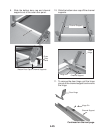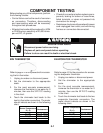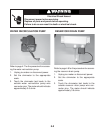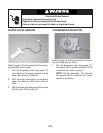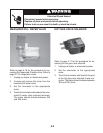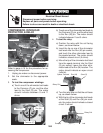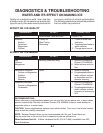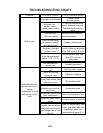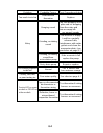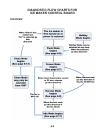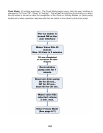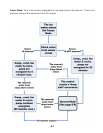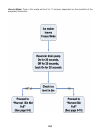
6-1
DIAGNOSTICS & TROUBLESHOOTING
WATER AND ITS EFFECT ON MAKING ICE
Quality ice is defi ned as solid, clear, and free
of taste or odor. All ice makers can provide this
type of ice only if the water used to produce the
ice is pure, and free of mineral contamination.
The following charts show some of the problems
that can affect ice production.
EFFECT ON ICE QUALITY
EFFECT ON ICE MAKER
INGREDIENT
EFFECT CORRECTION
Algae
Minerals:
Sodium
Potassium
Magnesium
Calcium
Objectionable Taste and Odor
Cloudy Ice
Slow Cutting
Refreezing
Carbon Filter
1. Check for water flow
restriction
.
2. Polyphosphate feeder or
water softener
3. Change water source
INGREDIENT
EFFECT CORRECTION
Iron
Chlorine
Manganese
Permanent Hardness
Calcium or Magnesium
Sulfates
Chlorides
Nitrates
Temporary Hardness
Calcium or Magnesium
Carbonates
Staining (Aesthetics only)
Scale
Scale
1. Use only Ice Machine
Cleaner P/N 4396808
Use only Ice Machine
Cleaner P/N 4396808
2. Water softener and iron
filter
1. Abrasive cleaning
2. Polyphosphate feeder or
water softener reduces
or eliminates need for
abrasive cleaning
1.
2. Polyphosphate feeder or
water softener reduces
frequency of cleaning by
50%
RECOMMENDATIONS:
Water softeners or polyphosphate feeders are not cure-alls, but do reduce and, in some cases,
prevent scale buildup. Use only Ice Maker Cleaner (P/N 4396808) if there is scale buildup on
evaporator plate or in water hoses.
CAUTION: Some polyphosphate feeders cause slime buildup. Their use in low mineral content
water should be carefully considered.
NOTE: Reverse Osmosis filters are not recommended with this unit. These filters can
limit the water flow to the unit and limit its capacity to produce sufficient ice.
Water Hardness Test Kit:
A Water Hardness Test Kit (P/N 4171690) is available from FSP
Parts Distribution.



